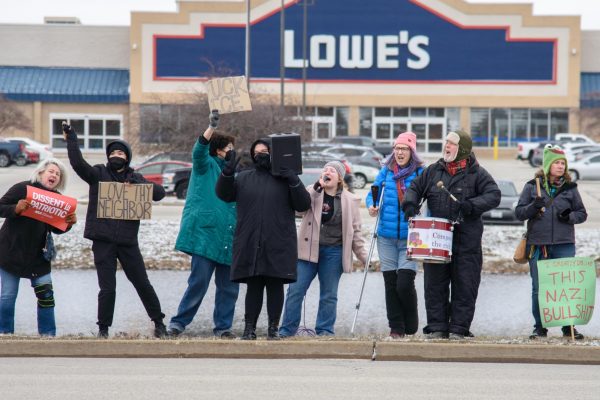Authorities hunt for clues in Times Square blast, rule out link to Capitol Hill letters

Mar 7, 2008
Last updated on May 12, 2016 at 10:45 p.m.
NEW YORK – Authorities on Friday were investigating whether an explosion at the Times Square military recruiting office was connected to strikingly similar bombings at two foreign consulates in New York, but ruled out a link to mysterious letters sent to Capitol Hill offices.
Investigators were also scrutinizing surveillance video and forensic evidence after a bicycle-riding bomber struck the landmark station Thursday, scarring one of the world’s most recognizable locations.
Authorities said there was no connection between the blast and a letter sent to as many as 100 members of Congress bearing the words “Happy New Year, We Did It.”
The lengthy anti-war letters – which arrived with photos of a man standing in front of the recruiting office before it was damaged – contained no threats, officials said.
Get The Daily Illini in your inbox!
Laura Eimiller, an FBI spokeswoman in Los Angeles, said an individual was questioned there about the letters to Congress and “there is no evidence linking the letters, which contained no threat, to the bombing.”
A law enforcement official in Washington, who spoke on condition of anonymity because the investigation of the bombing is continuing, called the timing of the letters an “incredibly unbelievable coincidence” and said no charges were expected in connection with them.
Democratic lawmakers were startled to receive the letters in their office mail just hours after the early morning New York bombing, and turned them over to the Capitol Police.
One law enforcer said the “We did it” referred to the Democratic wins. The Democrats gained control of Congress in 2006.
On Friday, Times Square was back to business as usual, filled with pedestrians and tourists snapping pictures. There was a sense of resolve among the military people guarding the mangled recruiting station.
“I hope that people see that nothing affects us. They can bomb the place, protest, but we’re going to continue recruiting,” said Sgt. 1st Class James Latella.
He added that four people had asked to enlist there Thursday night. The building, in the middle of a traffic island, was staffed all night because its twisted and shattered front door had been removed.
The Times Square bomb, contained in a metal ammunition box, produced a sudden flash and billowing cloud of white smoke. When the smoke cleared, there was no serious damage, nor any clear indication of a motive.
But like similar attacks in 2005 and last year on the British and Mexican consulates, the explosion frayed nerves of New Yorkers and tourists alike. It also heightened speculation that all three incidents were the work of a lone bomber who, perhaps emboldened by his past attacks, sought out the bright lights of Times Square.
“Times Square is ‘the crossroads of the world,’ and we’re concerned about it,” Police Commissioner Raymond Kelly said at a news conference.
The blast left a gaping hole in the recruiting station’s front window and shattered a glass door, twisting and blackening the building’s metal frame. Guests at the nearby Marriott Marquis said they heard a bang and felt the building shake.
Police released a private security video showing a figure riding along a traffic island in the glow of Times Square’s neon signs at about 3:38 a.m and getting off the bike just outside the recruitment center. About two minutes later, the cyclist rides away. Then the explosion occurs.
The images were too murky for police to get a clear description of the cyclist. But investigators were studying other security videos, including one showing a man exiting a subway station about 10 blocks away, carrying a bicycle, police said. The FBI was analyzing forensic evidence collected at the scene, Kelly said.
The commissioner cited other possible clues: a new bike discovered at about 7 a.m. in a trash bin a few blocks from the blast, and the sighting of a man on a bike near the scene moments before the explosion.
The man caught a witness’ attention because he was riding slowly, wearing a backpack and a hooded jacket, Kelly said. The witness, who was buying a newspaper at the time, said the hood “pretty much covered” the rider’s face.
The blast bears a striking resemblance to the two consulate explosions.
In October, two small explosive devices were tossed over a fence at the Mexican Consulate, shattering some windows; police said they believed someone on a bicycle threw the devices.
At the time, police said they were investigating whether it was connected to a nearly identical bombing at the British consulate on May 5, 2005. No one was arrested in either incident.
Those bombings involved dummy hand grenades packed with black powder as an explosive, Kelly said. He said investigators were working to determine whether similar powder was used in the Times Square blast, but he noted that the explosive used Thursday was carried in an ammunition box, rather than a grenade.
Similar ammunition boxes are readily available in Army-Navy surplus stores, Kelly said.
In another sign that the three blasts may be related, all occurred between 3:30 a.m. and 4 a.m.
The previous episodes generated nowhere near the response that the Times Square blast did. Kelly, Mayor Michael Bloomberg and the top FBI official in New York appeared at a nationally televised news conference in Times Square, and presidential candidates issued statements condemning the blast.
Bloomberg said the act “insults every one of our brave men and women in uniform stationed around the world.”
Associated Press writers Matt Apuzzo and Lara Jakes Jordan in Washington, and Ula Ilnytzky and Clare Trapasso in New York contributed to this report.





